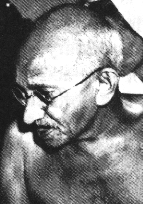Mahatma Gandhi´s Life
![]()
|
|
| |
Back to Index Page |
Mohandas (Mahatma) Gandhi
(1869-1948)
By Antonio Gaspar
Original in Spanish, translation by Luis Prada
![]()
 Mohandas Gandhi was born in the Indian city of Porbandar on October 2, 1869. At age 13 his parents arranged his marriage with a girl of his same age, Kasturba, with whom he had four children. Later on he traveled to London, England, to study laws. He returned to India in 1891 to practice as a lawyer in Bombay.
Mohandas Gandhi was born in the Indian city of Porbandar on October 2, 1869. At age 13 his parents arranged his marriage with a girl of his same age, Kasturba, with whom he had four children. Later on he traveled to London, England, to study laws. He returned to India in 1891 to practice as a lawyer in Bombay.
After two years he was sent to South Africa as legal adviser of an Indian firm in Durban. In this place he found a climate of rejection towards the Indian immigrants, to whom were denied civil liberties and political rights. At this moment he decided to fight for the rights of his compatriots. He remained in South Africa for twenty years, during which he was incarcerated in numerous occasions.
He was attacked and beaten in 1896 by white South Africans, and then he started to practice the politics of non cooperation and pacific resistance.
He called his movement Satyagraha, Embrace to Truth. He founded at Durban in 1910 a cooperative colony for the Indian immigrants, the Tolstoi farm. In 1914 the government of South Africa granted important concessions to Gandhi’s demands, such as the recognition of their marriages and municipal tax exemptions. Gandhi then returned to India,considering as finished his objectives in Africa.
In 1915 Gandhi founded the Indian National Congress, with the objective of achieving the independence of India of the British control. In 1920, considering that England did not grant the reforms requested by Gandhi, he started a program of pacific resistance, civil disobedience and boycott to British products. His movement gained millions of adepts throughout all India. Indians that occupied public posts resigned, children abandoned the public schools and the streets of the cities were frequently blocked by citizens that refused to stand up even in spite of being beaten by police. Gandhi was arrested, but the British authorities were forced to free him.
Gandhi carried an ascetic life of fasting and meditation. He refused material possessions, dressed with a mantel and a loincloth, and ate fruits and goat’s milk. He called his non-violent doctrine ahimsa, that in Sanskrit means "without hurting". His followers called him Mahatma, Great Soul, a title that was used to describe the great sages. He promulgated the development of crafts, mainly the textile, to solve the extreme poverty produced by the exploitation of the British industries.
In 1921 the National Indian Congress granted Gandhi plain executive authority. However, despite his efforts for peace, among the population broke out a series of revolts against England. Gandhi felt discouraged by the failure of his efforts to achieve independence by pacific means, and resigned. He was incarcerated by the British government in 1922.
He was freed in 1924 thanks to many international and popular pressures, and he retired from public life. However, he found himself involved again in the fight for independence. He proclaimed a new campaign of civil disobedience in 1930, with the famous March of the Salt. According to the British law, Indians could not produce salt, but were forced to buy it in licensed factories, all of them belonging to British people. Gandhi organized a march of 24 days from Porbandar to the sea, to obtain salt with water of the ocean. Thousand of people joined this march.
In 1934 he formally abandoned politics, leaving Jawaharlal Nehru as the leader of the Indian National Congress. Gandhi traveled through India preaching non-violence and defending the Indian caste of the untouchables, the lowest and most displaced social class of his country. In 1939 he returned again to political life with the objective of joining the principalities of India with the rest of the country.
At the break of the Second World War India supported England and her allies against Germany and Japan. However Gandhi and Congress demanded a declaration of intentions with respect to the war and its effects in Indian politics. Gandhi was imprisoned in 1942, but liberated two years later because of his health.
At the end of the Second World War, the British government accepted to concede independence to India with the condition that the rivaling groups, the Indian National Congress and the Muslim League resolve their differences. They opposed to the creation of a state for the Muslims, and even though Gandhi did not agreed with the division of India, accepted with the hope of achieving peace and independence. Independence was then granted in 1947, with the creation of Pakistan.
During the rest of his life Gandhi dedicated himself to try to achieve peace among Hindus and Moslems. During the disturbances that suffered the city of Calcutta, Gandhi fasted until violence stopped. In January of 1948 he initiated a hungry strike in New Delhi to promote peace. On January 30 of 1948, just after finishing this fasting, when he was heading for his customary afternoon prayer, Gandhi was assassinated by a Hindu extremist, Vinayak Nathura Godse, who opposed the reforms that defended the Muslim minorities.
The General Assembly of the United Nations decreed a period of mourning for his death, and the international community expressed his condolences. The efforts of Gandhi and his doctrine of ahimsa, the non-violence, has become an inspiration for all pacifist movements of the world.
![]()

Leave a Reply